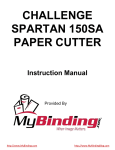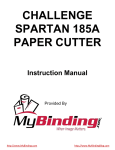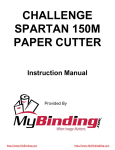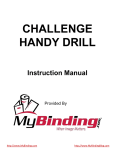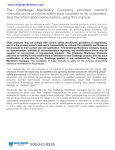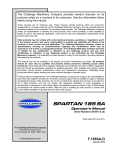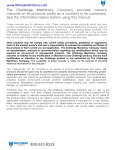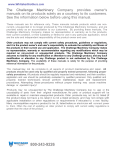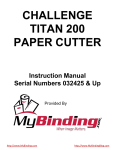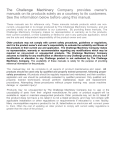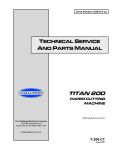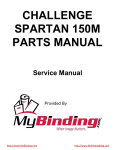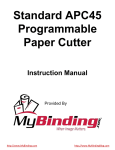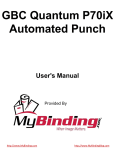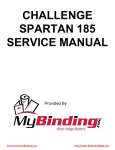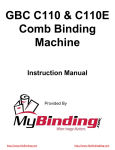Download My Binding Challenge Spartan 150M Service manual
Transcript
CHALLENGE SPARTAN 150SA PAPER CUTTER Service Manual Provided By http://www.MyBinding.com http://www.MyBindingBlog.com Serial Numbers 041001 & Up TECHNICAL SERVICE AND PARTS MANUAL SPARTAN 150 SA SEMI-AUTOMATIC PAPER CUTTER Sold and Serviced by The Challenge Machinery Company 6125 Norton Center Drive Norton Shores, MI. 49441 www.challengemachinery.com F.150-T Dec. 2004 1.0 Introduction 1.0 Introduction THIS MANUAL is designed to help you get the most from your Challenge equipment. Keep this manual in a safe, convenient place for quick reference by operators and service personnel. SAFETY ALERT! This symbol means CAUTION: Personal safety instructions! Pay special attention to the instructions in bold type. Personal injury may result if the precautions are not read and followed. FOR PARTS AND SERVICE contact the Authorized Challenge Dealer from whom you purchased your machine. Use the illustrations and parts lists at the back of this manual to identify the correct parts needed. Always give the SERIAL NUMBER and MODEL of your machine to insure the correct parts are sent as soon as possible. Challenge® is a registered trademark of The Challenge Machinery Company• 6125 Norton Center Drive • Norton Shores, MI 49441-6081 Copyright© 2004 by The Challenge Machinery Company. All rights reserved. Printed in the U.S.A 2 1.0 Introduction TABLE OF CONTENTS 1.0 Introduction....................................................................................................................................... 2 2.0 Safety ............................................................................................................................................... 4 2.1 Precautions .................................................................................................................................. 4 2.2 Power Lockout Procedure............................................................................................................ 4 2.3 Warning Label Definitions ............................................................................................................ 5 3.0 Maintenance Guide .......................................................................................................................... 7 3.1 Routine Maintenance ................................................................................................................... 8 3.1.1 Weekly .................................................................................................................................. 8 3.1.2 Monthly ................................................................................................................................. 8 3.1.3 Yearly.................................................................................................................................... 8 3.2 Cleaning ....................................................................................................................................... 8 3.2.1 Table ..................................................................................................................................... 8 3.2.2 Display Panel........................................................................................................................ 8 3.2.3 Machine Exterior................................................................................................................... 9 3.3 Lubrication.................................................................................................................................... 9 3.3.1 Clamp.................................................................................................................................... 9 3.3.2 Backgauge Leadscrew ....................................................................................................... 10 3.4 Adjustments ............................................................................................................................... 10 3.4.1 Squaring the Backgauge .................................................................................................... 10 3.4.2 Backgauge Accuracy Adjustment....................................................................................... 12 3.4.3 Knife Bar Gib Adjustments ................................................................................................. 13 3.4.4 Knife Leveling Adjustment .................................................................................................. 14 3.4.5 Backgauge Gib Adjustments .............................................................................................. 15 3.4.6 Leadscrew Collars .............................................................................................................. 16 3.4.7 Line Light Adjustment ......................................................................................................... 17 3.4.8 Front Guard Switch Adjustment.......................................................................................... 18 3.4.9 Knife Up Limit Switch Adjustment....................................................................................... 19 3.4.10 Knife Down Limit Switch Adjustment ................................................................................ 20 3.4.11 Backgauge Encoder/Belt Adjustment ............................................................................... 21 3.4.12 Re-engaging the Knife Pull-Down Gear ........................................................................... 22 3.5 Troubleshooting ......................................................................................................................... 24 4.0 Parts Lists....................................................................................................................................... 26 4.1 Main Assembly – Backgauge Bracket ....................................................................................... 26 4.2 Main Assembly – Leadscrew ..................................................................................................... 28 4.3 Main Assembly – Knife Drive ..................................................................................................... 30 4.4 Main Assembly – Bottom Side Electrical ................................................................................... 32 4.5 Main Assembly – Clamp ............................................................................................................ 34 4.6 Main Assembly – Knife .............................................................................................................. 36 4.7 Main Assembly – Front Shield ................................................................................................... 38 4.8 Main Assembly – Backgauge..................................................................................................... 40 4.9 Main Assembly – Top Side Electrical......................................................................................... 42 4.10 Main Assembly – Covers and Labels....................................................................................... 44 4.11 Main Assembly – Accessories ................................................................................................. 46 4.12 Motor and Gearbox Assembly – Sheet 1 ................................................................................. 48 4.13 Motor and Gearbox Assembly – Sheet 2 ................................................................................. 49 4.14 Motor and Gearbox Assembly – Sheet 3 ................................................................................. 50 4.15 Backgauge Assembly .............................................................................................................. 51 4.16 Magnet Assembly..................................................................................................................... 52 4.17 Electrical Power Panel Assembly ............................................................................................ 53 4.18 Wire Harness Assembly........................................................................................................... 54 4.19 Electrical Schematic................................................................................................................. 56 4.20 Electrical Interconnection Diagram .......................................................................................... 57 4.21 Label – Fuse Replacement ...................................................................................................... 58 4.22 Optional Floor Stand Assembly ............................................................................................... 59 3 2.0 Safety 2.0 Safety 2.1 Precautions • • • • • • • • • • • • • • • • This machine is designed for one-person operation. Never operate the machine with more than one person. Safe use of this machine is the responsibility of the operator. Use good judgment and common sense when working with and around this machine. Read and understand all instructions thoroughly before using the machine. If questions remain, contact the dealer from which you purchased this machine. Failure to understand the operating instructions may result in personal injury. Only trained and authorized people should operate this machine. DO NOT ALTER SAFETY GUARDS OR DEVICES. They are for your protection. Severe personal injury may result. Disconnect power before cleaning or performing maintenance. See Section 2.2 Power Lockout Procedure. Observe all caution labels on this machine. Be sure the cutter is properly grounded. Be sure there is sufficient power to operate the cutter properly. Observe all caution plates mounted on this cutter. Keep foreign objects off table and away from cutter blade. BE EXTREMELY CAREFUL when handling and changing the cutter knife. Severe lacerations or dismemberment could result from careless handling procedures. Keep the floor around the cutter free of trim, debris, oil and grease. When replacing hydraulic parts, loosen the connections slowly to release pressure. Never loosen connections with the machine running. If the cutter sounds or operates unusually, have it checked by a qualified service person. CRUSH HAZARD, keep hand and fingers from under the clamp when clamping paper. Use Jogging Aid to load paper, and use the backgauge to push paper out before unloading. DO NOT REACH UNDER THE KNIFE AND CLAMP AREA! 2.2 Power Lockout Procedure For maximum safety while making adjustments or repairs to your machine, be sure to disconnect power to the machine. Disconnect the power plug from its socket Figure 1 - Main Power Disconnect 4 2.0 Safety 2.3 Warning Label Definitions The following warning labels are found at various locations on your machine. Read and understand the meaning of each symbol. If a label is lost from the machine, it should be replaced. HAZARDOUS AREA Disconnect power before cleaning, servicing, or making adjustments not requiring power. Do not alter safety guards or devices; they are for your protection. Replace all guards. Do not operate with any guards removed. SHOCK HAZARD Disconnect power before removing cover. Replace cover before operation. SHOCK HAZARD Disconnect power before removing cover. Replace cover before operation. SINGLE OPERATOR Do not operate with more than one person. 5 2.0 Safety !OJO! This Este simbolo de alerta de seguridad significa ¡ OJO ! INSTRUCCIONES DE SEGURIDADPERSONAL. Lea las instrucciones porque se refieren a su seguridad personal. Fall de obedecer las instrucciones que siguen podria resultar en lesiones corporales. • • • • • • • • • • • • • • • • • • • • Esta maquina, junto con sus mecanismos de seguridad, esta disenada para ser manejada por UNA SOLA PERSONA a la vez. Jamas debe ser manejada por mas de una persona al mismo tiempo. La seguridad es la responsabilidad del operario que usa esta maquina. LEA DETENIDAMENTE el manual de instrucciones y las PRECAUCIONES DE SEGURIDAD antes de poner a funcionar la cortadora. Pidale a su supervisor una copia. El manejo de la guillotina debe estar exclusivamente a cargo de personal entrenado y autorizado para ello. NO MODIFIQUE LOS MECANISMOS DE SEGURIDAD, estan ahi para su proteccion no deben ni modificarse ni quitarse. DESCONECTE LA CORRIENTE ELECTRICA antes de proceder a hacerle servicio de limpieza, engrasar, o de hacer adjustes que no requieren corriente. Trabe el interruptor en la posicion OFF (apagado); vea “Procedimiento para cortar la corriente electrica” al pie de esta pagina. Eche llave a la guillotina y quite la llave cuando la maquina no esta en operacion; vea “Corriente electrica”. Asegurese de que la guillotina este debidamente a tierra. Vea “Conexion de la fuerza electrica”. Verifique el voltaje y asegurese de que este sea suficiente para el debido funcionamiento de la guillotina. Preste atencion a todas las placas con advertencias instaladas en esta guillotina. No permita que objetos estranos esten en la mesa o cerca de la cuchilla cortadora. TENGA SUMO CUIDADO al tocar y cambiar la cuchilla. Heridas severas y hasta desmembramiento pueden resultar del manejo sin cuidado o negligente. El suelo alrededor de la guillotina debe mantenerse despejado y libre de recortes, desperdicios, aceite y grasa. Al haber la necesidad de reemplazar partes hidraulicas, afloje todas las conexiones poco a poco para dejar escapar la presion. Jamas debe aflojarse conexiones mientras la maquina este andando. Si la guillotina empezara a sonar o trabajar diferentemente a lo acostumbrado, desconectela y consulte la seccion “Troubleshooting” (Reparador) de este manual. Si no es posible corregir el problema, llame a su servicio autorizado para que le examinen la maquina. PELIGRO DE MACHUQUE - Mantenga manos y dedos fuera de la agarradera mientras sujeta el papel. Use el calibrador trasero y su rueda de mano para empujar el papel cortado. NO PONGA SUS MANOS BAJOLA CUCHILLA O AREA DE LA AGARRADERA. NO OPERE SIN LAS GUARDAS PROTECTORAS! ¡ OJO ! PRECAUCION - Como proceder para desconectar la corriente electrica. Para maxima seguridad durante ajustes y reparaciones de su maquina, verifique bien que el interruptor principal de control de corriente al cual la maquina esta conectada, este desconectado. El interruptor deba ser puesto en la posicion “OFF” (desconectado) y se debe poner un candado en la anilla. La llave del candado debe ser guardada por la persona que estara efectuando los trabajos de servicio o de reparacion en la guillotina. Desconecte la corriente electrica antes de proceder a hacer cualquier ajuste o reparacion o de efectuar el engrase en cualquier maquina. 6 3.0 Maintenance Guide 3.0 Maintenance Guide NOTICE The instructions on the following pages are for the use of trained service personnel only! Attempting to perform repair and replacement procedures without proper training may cause machine damage or operator injury! PARTS CUSTOMERS: The Challenge Machinery Company provides parts with the express understanding that they are to replace parts found missing or no longer serviceable on equipment designed and/or manufactured by Challenge. The Challenge Machinery Company assumes no liability for any modification or alteration to any Challenge products, and any such modification or alteration to any Challenge product is not authorized by The Challenge Machinery Company. Any modification or alteration of any Challenge product will void any remaining warranty. 7 3.0 Maintenance Guide 3.1 Routine Maintenance DISCONNECT POWER before making any adjustments or lubricating. See page 4, SAFETY PRECAUTIONS, for Power Lockout Procedure. A clean, lubricated machine will run longer, smoother, cut more accurately, with less downtime and fewer costly repairs. Schedule lubrication both early in the day and early in the week. This allows the lubricants to work into the machine. Lubrication at the end of the day or week allows the lubricants to run off without as much benefit to the machine. The following guidelines will help you set up a regular maintenance schedule: 3.1.1 Weekly • Clean — Clean off old, dirty excess grease. Remove the top cover and clean accumulated dust off knife bar and gib areas. Built-up dust can increase wear to components. • Hardware — Remove top cover and bottom cover to check all nuts and bolts for tightness. Loose hardware is the cause of most component wear and in the electrical area could cause short circuits and/or shock. • Lubrication — See section 3.3 page 9 3.1.2 Monthly • Backgauge Squaring — See section 3.4.1 page 10 3.1.3 Yearly • Knife Bar Gib Adjustment — See section 3.4.3 page 13 • Backgauge Accuracy Adjustment — See Section 3.4.2 page 12 3.2 Cleaning Before cleaning inside machine, turn power off and disconnect power cord. 3.2.1 Table • The front table should be wiped down periodically. Use a non-abrasive cleaner along with a protective wax. • The rear table cover and front shield may be cleaned with glass cleaner or a mild water based detergent. Some petroleum-based solvents may damage the Plexiglas. 3.2.2 Display Panel • 8 The display panel should be cleaned with a mild water based detergent applied to a damp cloth or paper towel. Petroleum based solvents will damage the display. 3.0 Maintenance Guide 3.2.3 Machine Exterior • The machine’s exterior should be cleaned with a non-abrasive water based detergent applied to a damp cloth. • Always be careful when cleaning around safety warning labels. Use limited amounts of cleaners in those areas. 3.3 Lubrication 3.3.1 Clamp Send the knife down by activating a cut cycle and when the knife reaches the bottom, release only the right cut button and turn off the power before releasing the left cut button. Disconnect the power cord and remove the top cover for access. Wipe off any old or excess grease. Apply grease to the areas shown in Figure 2 and Figure 3 below. Grease Grease Figure 2 Grease Leadscrew Figure 3 9 3.0 Maintenance Guide 3.3.2 Backgauge Leadscrew With the top cover ON, place machine on a flat level surface on it’s left side and remove bottom cover. Use any brand-name type of grease or light oil to lubricate backgauge leadscrew (Figure 4). It may be helpful to use a small brush to apply grease. Note: the leadscrew may be lubricated with grease or oil. Oil has a tendency to run off and must be lubricated more frequently; grease tends to collect paper dust and must be cleaned off periodically. Grease Leadscrew Figure 4 3.4 Adjustments Some of the following tests require the machine to be operational for checking and adjusting. Be very careful that tools and other people are clear of moving parts and that the cutter is not accidentally operated while adjustments are being made. Whenever possible, disconnect the power and lock it out (see SAFETY PRECAUTIONS, page 4) unless the directions specifically require the machine to be powered. 3.4.1 Squaring the Backgauge To test if the backgauge is square, place a small lift of paper against the left side of the backgauge (but not against the side guide) and make a cut. Now, leave the backgauge in the same position, flip the lift over and push it against the right side of the backgauge (but not against the side guide). Make another cut to see if any of the paper will trim off (Figure 5). Run two checks, one starting on the left and moving to the right; the other, moving from the right to the left. If paper is trimmed in either sequence, the backgauge is out of square. 10 3.0 Maintenance Guide Figure 5 To square the backgauge: 1. Make sure the backgauge gibs are set properly (see section 3.4.5 ). 2. Remove the rear Plexiglas table cover. 3. Loosen the jam nuts on the backgauge adjusting screws. (Figure 6). Backgauge Adjusting Screws Backgauge Adjusting Screws Figure 6 4. Back off the adjusting screw on the side that the trim occurred, then tighten the other screw. 5. With the squaring screws tight, make another test. Continue to adjust and test until no trim occurs when testing either sequence. 6. Replace the rear Plexiglas table cover. 11 3.0 Maintenance Guide Note: Once the backgauge is square, check the backgauge accuracy (see section 3.4.2 ) to make sure it is accurate. 3.4.2 Backgauge Accuracy Adjustment If the backgauge position readout does not match the actual measurement between the knife and the backgauge, the accuracy can be adjusted. The accuracy can be checked by the following procedure: NOTE: The backgauge should be squared before attempting to adjust the accuracy. (See Section 3.4.1 Squaring the Backgauge, page 10.) 1. Place a 1/4 to 1/2” lift of 8-1/2 x 11 “ paper against the center of the backgauge. 2. Using the backgauge position readout, bring the lift up to the 10.00” position and make a cut. Then move the backgauge up to 5.00” and make another cut. 3. Take a sheet from the center of each lift and compare them to each other. The cutter will always space accurately between cuts (in this case the 10” and 5” cuts) whether the overall accuracy is correct of not (Figure 7). The front stack will be a true 5”, but the paper left against the backgauge will not be if the backgauge position is inaccurate. Accurate Questionable Figure 7 4. The backgauge accuracy can be corrected by adjusting the preset screw attached to the bottom of the backgauge nut assembly (Figure 8). Turn off power and disconnect the power cord. With the top cover ON, place machine on a flat level surface on it’s left side and remove bottom cover. Place a 3/16” Allen wrench in the preset screw and hold in position while loosening the jam nut. Now adjust the screw as follows: • • If test pile is short (back pile is less than 5”), turn screw out (counterclockwise). If test pile is long (back pile is more than 5”), turn screw in (clockwise). 1/4 turn = .012” backgauge adjustment 1/3 turn = .016 (1/64”) 1/2 turn = .024” 2/3 turn = .032” (1/32”) 1 turn = .048” 12 3.0 Maintenance Guide Preset Screw Figure 8 5. Replace bottom cover, lay machine flat, and turn on power. Note: If power was not off, reset power now or else reading will be false. Bring the backgauge to the front to reset the display and make another test. Repeat adjustment procedure if necessary. 3.4.3 Knife Bar Gib Adjustments 1. Make sure knife is in up position and turn off power and disconnect power cord. 2. Remove clamp hand wheel and top cover. 3. Loosen the gib screw jam nuts on the TOP TWO GIB SCREWS ONLY on each side (Figure 9). Top Two Knife Bar Gib Screws Top Two Knife Bar Gib Screws Bottom Knife Bar Gib Screw Bottom Knife Bar Gib Screw Figure 9 4. Tighten gib screws so that screws are just snug then add a 1/8 turn. Hold screws in position with tool then tighten jam nuts. 13 3.0 Maintenance Guide 5. Replace top cover, plug in power cord, turn power on, and start a cut cycle. 6. When knife is all the way down, release right cut button only and switch off power. 7. Now with the knife in the down position, disconnect power cord, remove top cover, and repeat gib screw adjustment for the BOTTOM GIB SCREW on each side. 8. Replace top cover and clamp handle. 3.4.4 Knife Leveling Adjustment If knife cuts through one side of paper and not the other, the knife level may need adjustment. First check to make sure the knife is all the way up in knife bar by looking through the viewing holes in the knife bar (Figure 10). If it is not all the way up, loosen the knife screws and use knife lifter assembly to raise knife up tight. Recheck knife by cutting through paper. Viewing Holes Figure 10 If knife is not cutting through paper evenly, use the following procedure to adjust: 1. Flip the cut stick to a new position and raise the knife depth by several turns of the screw (see Operator’s Manual for more information on how to do this). 2. Place a few sheets of paper over the entire cut stick, and set the knife depth so that it just cuts through the bottom sheet of paper on one side (see Operator’s Manual for more information on how to do this). 3. Slightly loosen the left-most knife screw (but keep somewhat snug). 4. With the paper still in place, send the knife down by making a cut and continue to hold in the left cut button while releasing the right cut button and turning off power. Disconnect power cord. 5. Remove the clamp handle and top cover. 14 3.0 Maintenance Guide 6. Slightly loosen the remaining (5) knife screws, keeping them somewhat snug. 7. Adjust the knife leveling screw (Figure 11) that corresponds with the side of the knife which does not cut all the way through. Tug on the paper while adjusting and stop when the bottom sheet is cut all the way through. Knife Leveling Screws Figure 11 8. Tighten the (5) accessible knife screws, replace top cover and clamp handle, restore power to machine, raise up knife, and tighten (1) remaining knife screw. 3.4.5 Backgauge Gib Adjustments If the backgauge does not stay square or moves up and down or back and forth when jogging paper against it, the backgauge gib screws may be loose or worn. To Adjust: 1. Turn off the power and disconnect the power cord. 2. With the top cover ON, place machine on a flat level surface on it’s left side and remove bottom cover. 3. Loosen the two outside gib screw jam nuts (Figure 12, page 16). 15 3.0 Maintenance Guide Backgauge Gib Screw Backgauge Gib Screw Figure 12 4. Tighten the two nylon set screws until they just touch the guide. Do not over-tighten or they could cause the backgauge to bind. Lock in position with jam nuts. The center screw is a spring loaded plunger and should not need adjustment. 5. Run the backgauge back and forth the length of the table and check for any binding. Readjust if necessary. Replace the bottom cover and lay machine flat. 3.4.6 Leadscrew Collars Any play in the backgauge leadscrew should not cause inaccuracies in cutting. However, excessive play can be eliminated by adjusting the leadscrew collars as follows: 1. Turn off the power and disconnect the power cord. 2. With the top cover ON, place machine on a flat level surface on it’s left side and remove bottom cover. 3. Loosen the two screws attached to each collar (Figure 13). 16 3.0 Maintenance Guide Leadscrew Collars Figure 13 4. Make sure there is a slight gap between the front hand crank and the machine, slide collars up tight against the nylon washers and tighten the collar screws. 5. Check to make sure the hand crank turns freely with no play. 6. Replace bottom cover and lay machine flat. 3.4.7 Line Light Adjustment The line light can be adjusted if necessary as follows: 1. Remove the top clamp hand wheel and top cover. 2. Loosen the three line light mounting screws (Figure 14, page 18). 17 3.0 Maintenance Guide Line Light Mounting Screws Figure 14 3. Place a white sheet of paper over the cut stick and turn the power on to activate the line light. Note: 24V is being supplied to line light board while power is on. 4. Slide the line light assembly forward or backward to get a single, crisp line. 5. Tighten the screws and turn power off. Replace the cover and hand wheel. 3.4.8 Front Guard Switch Adjustment The front guard interlock switch must be adjusted correctly in order for machine to function properly and safely. To adjust: 1. Turn off the power and disconnect the power cord. 2. Remove clamp handle and top cover. 3. Loosen (2) screws and nuts that mount the front guard switch as seen in Figure 15. Make sure the front guard is lowered and slide the switch forward or backward until the actuator lines up with the flat on the hinge rod (Figure 15). Leave a very slight gap (about the thickness of a strip of paper) between the actuator and flat. 18 3.0 Maintenance Guide Hinge Rod Mounting Screws Figure 15 4. Tighten screws, replace cover and clamp handle. 5. Test to make sure machine works properly, using the test found at the end of this manual. 3.4.9 Knife Up Limit Switch Adjustment If the knife up limit switch becomes loose or needs adjustment, adjust as follows: 1. Turn off the power and disconnect the power cord. 2. With the top cover ON, place machine on a flat level surface on it’s left side and remove bottom cover. 3. If the knife pull-down gear is disengaged, engage it now. See Section 3.4.12 Re-engaging the Knife Pull-Down Gear, page 22. 4. Loosen bracket mounting screws (Figure 16, page 20), and slide bracket such that mounting screws become located in the center of the slots. Then tighten screws, and check to make sure screws mounting switch are tight also. Note: Apply temporary thread lock to bracket mounting screws to prevent screws from coming loose during operation. 19 3.0 Maintenance Guide Mounting Screws Figure 16 5. Replace bottom cover, lay machine flat, and turn on power. Make a cut. Check position of knife – USE CAUTION, THE KNIFE EDGE IS VERY SHARP. The edge of a new knife should be above the bottom of the clamp when the knife and clamp are in the “up” positions. If the knife edge is below the clamp, repeat the adjustment procedure described above, and move the bracket slightly in the slots to allow the knife to come up further. NOTE: the knife should not be able to come up so far that the gears become disengaged – or damage to the machine could result. 3.4.10 Knife Down Limit Switch Adjustment The down limit switch is normally adjusted by the operator from the exterior of the machine. No internal adjustments can be made, but the switch can be checked to ensure that it is functioning properly. To check switch assembly: 1. Turn off the power and disconnect the power cord. 2. With the top cover ON, place machine on a flat level surface on it’s left side and remove bottom cover. 3. Check all bracket and switch hardware to make sure they are tight (Figure 17). 20 3.0 Maintenance Guide Bracket Mounting Screws Limit Switch Switch Bracket Figure 17 4. Check to make sure the switch bracket slides freely on the mounting bracket. 5. Check condition of spring. 6. Replace bottom cover and lay machine flat. 3.4.11 Backgauge Encoder/Belt Adjustment The backgauge encoder system reads the position of the backgauge, and sends the information to the display. The encoder uses a belt and pulley system to read the actual position of the backgauge. The following checks and adjustments may be necessary to ensure the backgauge display reads properly and accurately: 1. Turn off the power and disconnect the power cord. 2. With the top cover ON, place machine on a flat level surface on it’s left side and remove bottom cover. 3. Inspect the encoder bracket and mounting screws (Figure 18, page 22). Make sure the bracket is not bent, and that the screws are tight. 21 3.0 Maintenance Guide Belt Encoder Pulley Bracket Mounting Screws Figure 18 4. Inspect the belt and make sure it is tight. If it is not, loosen the (2) screws at the rear of the machine, pull belt tight, then tighten the screws. 5. Make sure the pulley is properly lined up with the belt (Figure 18). If not, the position of the pulley can be adjusted by loosening the pulley set screw, then slide the pulley into place, then tighten the set screw. 6. Now move the backgauge forward and backward through its full range of motion, checking to make sure the pulley tracks along belt properly. 7. Replace bottom cover and lay machine flat. 3.4.12 Re-engaging the Knife Pull-Down Gear If the knife pull-down gear becomes disengaged, the following procedure must be followed in order to properly re-engage it: 1. Turn off the power and disconnect the power cord. 2. With the top cover ON, place machine on a flat level surface on it’s left side and remove bottom cover. 3. Disengage the motor brake by moving the brake lever counterclockwise (when looking at lever from front of machine) as shown in Figure 19. 22 3.0 Maintenance Guide Disengage Brake Figure 19 4. Now move the gears in the directions shown in Figure 19. Some machines are equipped with gears that have a small stub on them which can be used to turn the gear using a pliers or wrench if necessary. If the larger gear cannot be moved by hand, carefully tap on it with a rubber hammer, or carefully pry it with a long bar. Be very careful not to damage the gear teeth. Rotate the gears so that at least one whole tooth is engaged (Figure 20). Engage Brake Figure 20 5. Engage the motor brake by moving the brake lever clockwise (when looking at lever from front of machine) as shown in Figure 20). NOTE: The motor brake must be engaged before machine is powered up or damage to the machine could result. 23 3.0 Maintenance Guide 6. Check to make sure the up and down limit switches are positioned properly to prevent gears from becoming disengaged again (See Section 3.4.9 page 19 and Section 3.4.10 page 20). 7. Replace bottom cover and lay machine flat. 3.5 Troubleshooting Problem 1. The machine will not power up – no display, no line light, and machine will not cycle. Possible Cause a) Power cord is disconnected. b) Main power switch/circuit breaker is off. c) Blown fuse on main circuit board. d) Disconnected wires inside machine. e) No power at electrical outlet. 2. Display and line light are on, but machine will not cycle. a) Front guard is open. b) Front guard has not been opened and closed since previous cut cycle. c) Front guard switch needs adjustment. d) Knife limit switches need adjustment. e) Disconnected wires inside machine. f) Faulty cut button. g) Faulty main circuit board. 3. Power is on, but backgauge display is blank. a) Disconnected wires inside machine. b) Faulty display circuit board. a) Plug in cord. b) Turn power switch/circuit breaker on. c) Check fuse, replace if blown. d) Check for wires that are disconnected from main circuit board, power cord, etc. e) Check outlet. Repair or use another outlet. a) Close front guard. b) Open and close front guard. c) See Section 3.4.8 Front Guard Switch Adjustment, page 18. d) See Sections 3.4.9 Knife Up Limit Switch Adjustment, page 19 and 3.4.10 Knife Down Limit Switch Adjustment, page 20. e) Check for wires that are disconnected from main circuit board, cut buttons, etc. f) Check continuity of cut buttons at circuit board connection. Replace if necessary. g) Replace main circuit board. a) Check for wires that are disconnected from main circuit board, display circuit board, etc. b) Replace display circuit board. 4. Backgauge display shows: “----“. a) Backgauge has not been preset. a) Preset Backgauge by bringing backgauge to front of machine (see Operator’s Manual for more info). 5. Power is on, but line light does not light up. a) Disconnected wires inside machine. a) Check for wires that are disconnected from main circuit board, line light circuit board, etc. b) Replace line light circuit board. b) Faulty line light circuit board. 24 Solution 3.0 Maintenance Guide Problem 6. Backgauge display is inaccurate. Possible Cause a) Backgauge accuracy needs adjustment. b) Encoder malfunction. c) Faulty display circuit board. 7. Knife cuts deeper on one side than the other. a) Knife is not seated all the way up in knife bar. b) Knife level is not set properly 8. The machine strains through a cut. a) Dull knife. b) Paper clamped too tight. c) Inadequate power source. Solution a) See Section 3.4.2 Backgauge Accuracy Adjustment, page 12. b) Check encoder system (see Section 3.4.11 Backgauge Encoder/Belt Adjustment, page 21) or replace encoder. c) Replace display circuit board. a) Loosen knife screws and use knife lifter assembly to raise knife up tight. b) See Section 3.4.4 Knife Leveling Adjustment, page 14. a) Change the knife with a new or sharpened one. See Operator’s Manual for knife changing information and instructions. b) Apply less force on clamp handle when clamping paper. c) The electrical outlet may not have sufficient power if other equipment is operating on the same line. Check voltage and/or try another outlet on a different line. 9. Concave cutting – ends wide, center narrow. a) Excessive moisture at edges of paper. a) Keep paper in dry location. 10. Concave cutting – variation from top to bottom. a) Soft paper not firmly clamped. a) Apply more force on clamp handle when clamping. b) Change the knife with a new or sharpened one. See Operator’s Manual for knife changing information and instructions. 11. Motor runs at start up and does not stop running. a) Knife up limit switch out of adjustment. a) See Section 3.4.9 Knife Up Limit Switch Adjustment, page 19 12. Knife coasts after motor stops. a) Motor brake is disengaged. a) Engage motor brake (see Section 3.4.12 Re-engaging the Knife Pull-Down Gear, page 22. b) Replace motor brake. See Section 4.14 page 50 for part number. Replacement instructions included with part. b) Knife dull or incorrectly ground. b) Motor brake is worn out. 25 4.0 Parts Lists 4.0 Parts Lists 4.1 Main Assembly – Backgauge Bracket 60000 Sht. 1, Rev. B 26 4.0 Parts Lists Main Assembly – Backgauge Bracket 60000 Sht. 1, Rev. B 27 4.0 Parts Lists 4.2 Main Assembly – Leadscrew 60000 Sht. 2, Rev. B 28 4.0 Parts Lists Main Assembly – Leadscrew 60000 Sht. 2, Rev. B 29 4.0 Parts Lists 4.3 Main Assembly – Knife Drive 60000 Sht. 3, Rev. B 30 4.0 Parts Lists Main Assembly – Knife Drive 60000 Sht. 3, Rev. B 31 4.0 Parts Lists 4.4 Main Assembly – Bottom Side Electrical 60000 Sht. 4, Rev. B 32 4.0 Parts Lists Main Assembly – Bottom Side Electrical 60000 Sht. 4, Rev. B 33 4.0 Parts Lists 4.5 Main Assembly – Clamp 60000 Sht. 5, Rev. B 34 4.0 Parts Lists Main Assembly – Clamp 60000 Sht. 5, Rev. B 35 4.0 Parts Lists 4.6 Main Assembly – Knife 60000 Sht. 6, Rev. B 36 4.0 Parts Lists Main Assembly – Knife 60000 Sht. 6, Rev. B 37 4.0 Parts Lists 4.7 Main Assembly – Front Shield 60000 Sht. 7, Rev. B 38 4.0 Parts Lists Main Assembly – Front Shield 60000 Sht. 7, Rev. B 39 4.0 Parts Lists 4.8 Main Assembly – Backgauge 60000 Sht. 8, Rev. B 40 4.0 Parts Lists Main Assembly – Backgauge 60000 Sht. 8, Rev. B 41 4.0 Parts Lists 4.9 Main Assembly – Top Side Electrical 60000 Sht. 9, Rev. B 42 4.0 Parts Lists Main Assembly – Top Side Electrical 60000 Sht. 9, Rev. B 43 4.0 Parts Lists 4.10 Main Assembly – Covers and Labels 60000 Sht. 10, Rev. B 44 4.0 Parts Lists Main Assembly – Covers and Labels 60000 Sht. 10, Rev. B 45 4.0 Parts Lists 4.11 Main Assembly – Accessories 60000 Sht. 11, Rev. B 46 4.0 Parts Lists Main Assembly – Accessories 60000 Sht. 11, Rev. B 47 4.0 Parts Lists 4.12 Motor and Gearbox Assembly – Sheet 1 60005 Sht. 1, Rev. A 48 4.0 Parts Lists 4.13 Motor and Gearbox Assembly – Sheet 2 60005 Sht. 2, Rev. A 49 4.0 Parts Lists 4.14 Motor and Gearbox Assembly – Sheet 3 60005 Sht. 3, Rev. A 50 4.0 Parts Lists 4.15 Backgauge Assembly 60203 51 4.0 Parts Lists 4.16 Magnet Assembly 60052 52 4.0 Parts Lists 4.17 Electrical Power Panel Assembly EE-3061, Rev. B 53 4.0 Parts Lists 4.18 Wire Harness Assembly EE-3116, Rev. C 54 4.0 Parts Lists Wire Harness Assembly EE-3116, Rev. C 55 E-3062 4.19 Electrical Schematic 4.0 Parts Lists 56 4.20 Electrical Interconnection Diagram E-3125 Rev. B 4.0 Parts Lists 57 4.0 Parts Lists 4.21 Label – Fuse Replacement S-1781-129, Rev. B 58 4.0 Parts Lists 4.22 Optional Floor Stand Assembly 60065, Rev. B 59





























































